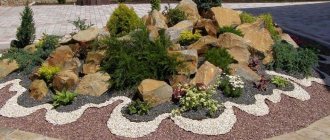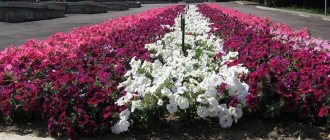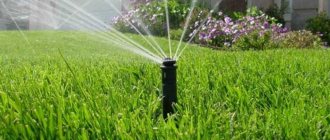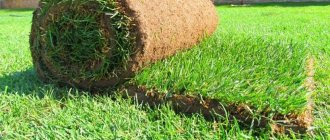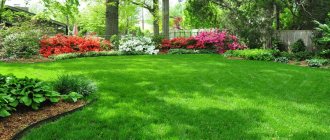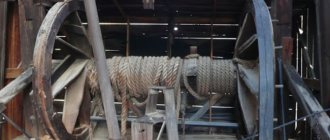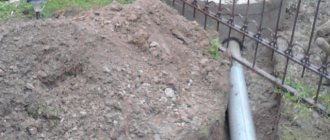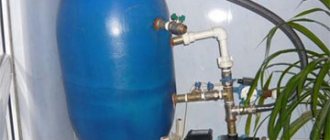Typical lawn watering options
When organizing a lawn watering system, the following should be highlighted:
- Manual. This method of irrigation is the most commonly used in practice. The popularity of such watering lies in the simplicity of the equipment - a hose of a certain length and a pistol nozzle are enough to spray water evenly and widely. Manual watering takes a lot of time, mainly due to dragging hoses and trees, shrubs, flower beds and other plants interfering with this process that are at risk of being damaged. Assessing soil moisture after watering is purely subjective. Ensuring uniform watering of the entire area, which is important for the uniform development of the entire area of lawn grass, cannot be achieved with manual watering.
- Semi-automatic. Semi-automatic watering includes more diverse equipment compared to manual watering - a system consisting of various pipes and flexible hoses is used, control valves, filters, and irrigation system devices (sprinklers, nozzles) are installed. The pressure in the system is created by a pump when using storage tanks or by a water supply system in their absence. The main advantage of a semi-automatic system over a manual one is that there is no need to drag the hose around the site and waste time on it. You only need to change the location of the sprinkler on the lawn after a certain time until it is completely watered.
However, the disadvantage of manual watering - the lack of complete and uniform irrigation of the entire lawn area - cannot be eliminated. - Auto. The highest quality lawn watering is done using automation. Automatic lawn watering systems do not require human activity during their operation. In addition to the elements that are part of the semi-automatic system, automatic lawn watering installations are equipped with electronic devices and sensors that monitor the control parameters of the system.
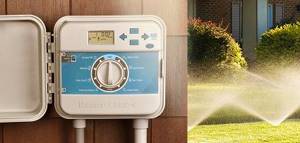
The high cost of installation for the consumer is paid off by guaranteed uniform watering of the entire lawn and comfortable conditions for watering control.
Automatic watering in Moscow - why us?
Our Company has been selling and installing automatic watering systems for many years.
During this time, we were able not only to gain valuable practical experience, but also to master the technologies and approaches of the world's leading Companies operating in this niche. Today, our store of auto-irrigation systems is known not only in its region, but also far beyond its borders for the fact that we have created the most comfortable conditions for cooperation and purchase of equipment.
Among the attractive features and advantages that we accompany cooperation with each client of the Company, buyers especially highlight:
Quality
All equipment, components and accessories presented in our Company are products from well-known manufacturers, guaranteeing high quality and impeccability, regardless of the intensity and durability of use. Due to the fact that all products are made from high-quality materials, even with constant contact with moisture or mechanical damage, as well as exposure to ultraviolet rays of the sun, equipment and components remain intact, efficient and productive, ensuring stable and high-quality watering of bushes and other plants on the site .
Range
Our retail store in Moscow today offers a huge variety of goods, designed not only for the area of plots and territories, but also for the financial capabilities of a wide variety of customers, among whom there are both retail and wholesale clients. Automatic watering of parks and other areas continues to be improved, so the number of models and various components required for installation of equipment in our catalog is constantly increasing and updated with new options. Depending on the type of site and other features, any client will be able to choose automatic lawn watering that ideally suits his needs.
Consultations
Each consultation on automatic lawn watering is provided in our Company by qualified specialists who, in practice, were able to verify the effectiveness of various approaches and installation features. That is why any client will be able to receive practical advice regarding the selection and purchase of accessories, and will also understand what types of installation of automatic watering systems will be more effective in his situation.
Price
In our Company, the price of automatic watering of any type of lawn is not only affordable, but also the most profitable. This is explained by the fact that over the years of work, we were able not only to establish close partnerships with well-known manufacturers, but also became official representatives of many of them in our region. For our regular customers, as well as those who buy automatic watering wholesale, we offer pleasant and profitable discounts on all types and varieties of goods. During the period of special promotions and sales that we regularly organize at the Company, the cost of a lawn watering system will be even more profitable and attractive.
The main user benefits from using automatic lawn watering
The following are the advantages of an automatic lawn watering system.
- Using simple manipulations with an electronic device, a person sets the lawn watering regime (frequency, duration of time). A mode is selected that will provide the best watering time for the lawn, which will eliminate the formation of yellow grass and make the lawn wear-resistant and durable.
- Automatic watering carries out watering specifically in place, the water is evenly distributed over the lawn. This ensures less water consumption compared to other types of irrigation.
- Sensors that monitor weather conditions, such as rain or soil moisture, cannot be configured. They work autonomously - they turn on/off the irrigation system to create better conditions for growing lawn grass. The image shows the Solar Sing model rain sensor:

- If the lawn area is uneven, where it is possible to drain water into lower areas, you can increase/decrease the supply level in individual areas by adjusting the controller program.
Pumps for lawn watering systems
A lawn watering system equipped with a pump minimizes the user's physical effort. Such devices are distinguished by high power, smooth water supply and long service life. This system is a good option for those who need to water their grass frequently.
How to make a lawn with your own hands: a detailed guide
There are several types of pumps designed for lawn irrigation. Their size and power vary: from a small compact compressor (for a plot of 6 acres) to a miniature pumping station (for watering lawns in city parks).
The following types of pumps are distinguished:
- Centrifugal - needed when intensive watering with the consumption of large volumes of liquid is necessary;
- Piston - used when water needs to be saved.
For your information. If you need to pump a small volume of water from one tank to another, it is best to use a rotary compressor.
Automatic irrigation methods
Depending on the equipment used, the following two types are distinguished:
- sprinkler;
- drip.
With the sprinkler method of irrigation, water is supplied under pressure to special devices that disperse it into small drops, creating an effect comparable to natural watering of grass with rain.
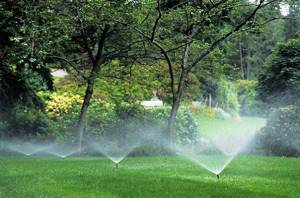
The drip method is carried out using perforated hoses placed throughout the irrigation area.
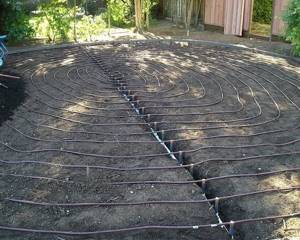
Used for small areas; the use of the method for lawns is very limited. Possible use options for lawns located in narrow and long areas.
The simplest ways to organize a watering system
The most accessible way for many to get rid of the need to go around the lawn with a hose, spraying water over it, is to lay pipes with adapters along the perimeter of the lawn. The latter, special corrugated, stretchable hoses, can be connected to lawn irrigation devices, which are placed at specific points to ensure spraying over the entire lawn area. Such a system is far from automatic, since most of the work: moving sprinklers and hoses, turning the water on and off - has to be done manually. But there is a significant reduction in labor costs.

If the lawn is a narrow strip, you can use a self-propelled sprinkler equipped with a base with wheels that can roll through thick grass. Often, an additional reel is installed on which the hose is wound, which significantly lengthens and facilitates the stroke. The movement of such a device along the site is ensured by the pressure of water, which pushes the cart, simultaneously bursting upward through the nozzle, providing a wide fan spray. The movement of the mobile sprinkler is uneven and jerky, but the strip along which it passes is completely irrigated.
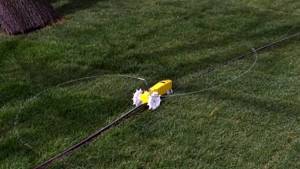
In order not to depend on the pressure in city communications, where the pressure may drop due to technical work, which will make it impossible to carry out the next irrigation, you can install an expansion tank and at the same time a storage tank. As such, it is allowed to use an ordinary barrel, plastic or stainless steel, raised on high supports with a platform at the top. Having filled a container equipped with a water supply tap to the humidification system, you don’t have to worry that one day, after turning the valve, not a drop of life-giving moisture will spill onto the lawn. Such a tank should also be connected to the rainwater inlet system.
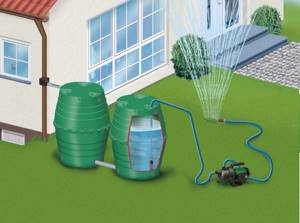
To save money, you can use a drip irrigation system, which significantly reduces water consumption by delivering it in portions to the very roots of the plants. If you use separate nozzles, then this method is practically unacceptable for the lawn and is more suitable for flower beds, flower borders and vegetable gardens. But there are solutions for lawns as well - laying perforated hoses at equal intervals across the entire grassed area. It is very convenient if a lawn grid is used for planting, then flexible drainage watering tubes can be stretched under it.
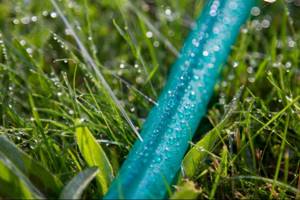
Equipment for automatic watering using the drip method
The main components of a drip irrigation system are as follows.
- Storage tank for water.
- Submersible pump. Installed in a storage tank. The pump capacity should be enough to water the entire lawn area.
- The pressure regulator is one of the important elements of stable operation of drip irrigation.
- Main pipe. It is connected to the pump through the tank lid or through a hole in the bottom of its wall. A fitting with sealing material is mounted into the hole, into which the main pipe is inserted using sealant.
- Additional pipes for wiring. Usually about 4 wirings are performed.
- Fitting. With their help, the connection of the main and distribution pipes into a single system is ensured.
- Calibrated holes are made in the pipes (the water consumption during irrigation will depend on the diameter of the holes).
- Controller. You can use a timer in a simplified version. It can work as an automatic element that regulates the operation of the pump. At a certain point in time, it turns on the power to the pump, and after a while turns it off.
- Solenoid valves (when installing a system with a controller). They are usually installed for drip irrigation at the inlet of the main pipe.
Do-it-yourself automatic lawn watering system
Once the decision to do it yourself has been made, it’s time to do some research. It is important to take into account such nuances as the frequency of sprinkler placement, watering time, and its duration. Living plants are sensitive to both a lack of moisture and its excess, which means an error in calculations can cost you your lawn or beds.
To assemble an automatic watering system at your dacha from plastic pipes (HDPE), pay attention to the size of your garden area. If its dimensions do not exceed 19 acres, then a diameter of 25-32 mm is enough, but if it is larger, a diameter of about 40 mm is needed. You will also need sprinklers and sprinklers, valves, a pump and storage tank, and drip hoses for slow watering (if you have beds or greenhouses). In addition, you will need a controller to control irrigation, and weather sensors. We talk more about this in other blog articles.
Equipment for automatic watering using sprinklers
Equipment for sprinkler irrigation with automatic lawn watering consists of the following main elements.
- Pump equipment. Designed to deliver water to the lawn watering area. Of all types of pumps, the most widely used are centrifugal pumps that are capable of maintaining the required pressure throughout the entire operating time.
- Storage capacity. Lawn grass should be watered with water, the temperature of which should not differ much from the ambient temperature. Therefore, water, for example, from a well before watering should be supplied to a storage tank, where it will be heated to the temperature required for watering the lawn. Next, using a pump, water will be supplied to the pipelines of the irrigation system.
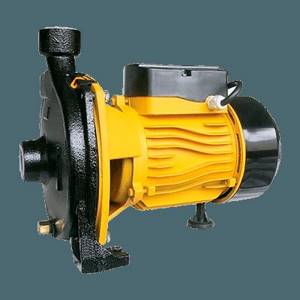
- Sprinklers (sprinklers, sprinklers). Depending on the type of water supply to the lawn, they can be fan or rotary. Fans water the lawn by spraying water 360°.
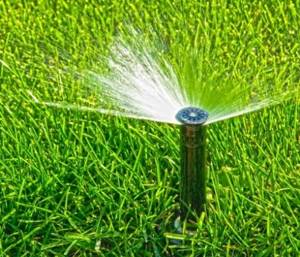
Rotary ones water only certain areas, and the design of certain models can change the angle of irrigation.
By replacing nozzles, a change in the irrigation radius is achieved.
Sprinklers for better watering are made with retractable stems. The length of the rod is selected in accordance with the size of the area of the lawn being watered. When not in use, the sprinklers are recessed into the ground so as not to interfere with the work of cutting the grass with a lawn mower.
- Filters. To prevent dirt and small debris from entering the sprinkler nozzles, filters are installed in the system.
- Pressure regulator. If the water supply to the irrigation system is characterized by inconsistent pressure, the installation of this special device is mandatory. It is adjusted to the parameter most effective for the operation of sprinklers. Sprinklers differ in operating pressure parameters. Grouped according to this indicator, they are included in the work one by one. Here it is important to adjust (set) the pressure specifically for a specific group of sprinklers.
- Pipeline. It consists of two parts - the main (main) pump connecting the sprinkler installation site and the sections of pipes through which water is supplied to them. The diameter of the main pipeline must be consistent with the size of the pump outlet. On branches, the diameter of the pipe should not differ greatly from the dimensions of the flow area of the solenoid valve. Important: the diameter of the main pipeline must be greater than the diameter of the branch pipes. Pipes are made of metal-plastic, polypropylene or the cheapest polyethylene (HDPE).
- Fitting. It is possible to create a branched system of pipes of different diameters with different types of turns using special connecting parts of pipelines - fittings.
- Solenoid valves. With their help, the water supply to the sprinklers is turned on/off according to the program specified by the controller. If, for example, the pump power is not enough to simultaneously water the entire area with a full set of sprinklers, it can be carried out in several sections. According to the program, the controller will give commands to turn on/off a particular valve.
- Controller. This is the electronic brain of the auto-irrigation control system. The valve operation is adjusted according to a programmed schedule. Rain sensors and humidity sensors can be connected to the controller. The first one turns off the water supply when weather conditions change and precipitation occurs. In normal weather, the system returns to its previous state. The moisture sensor signals when the lawn is saturated with the required amount of moisture and prevents the soil from becoming waterlogged.
- Water intake sockets. Installed on the main section of the pipeline system.
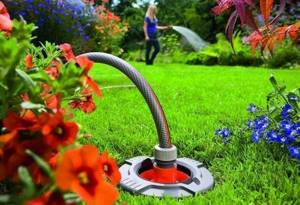
In addition to automatic watering of the lawn, they allow you to perform other types of work using water pressure: watering shrubs and flower beds, filling containers, washing walkways and others.
What are devices for automatic watering of plants made of?
The main parts that make up automatic watering devices are:
- Pump. This is one of the main elements that is installed directly near the water source. The power of the equipment must be selected depending on the size of the lawn. The pumping station includes: the pump itself, a hydraulic accumulator, a pressure switch and connecting pipes. It is recommended to install a filter to prevent sand and small impurities from entering the system. Electrical cables for powering the station should be laid underground, having previously protected them with a metal corrugated pipe. Centrifugal pumps are considered the best for automatic watering, characterized by their ability to maintain pressure for a long time.
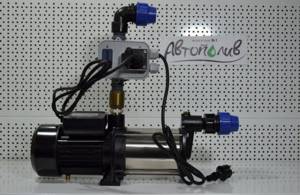
- Filter. This part is needed in order to minimize the likelihood of microcontaminants (sand, silt, etc.) getting into the system.
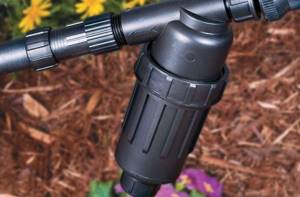
- Pressure regulator. Required to maintain proper operation of the system if the pressure in it is insufficient.
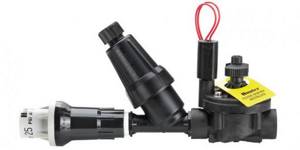
- Pipes, hoses. With sprinkler irrigation, one or two main pipes are laid, from which the rest are installed, supplying water to the sprinklers. It is advisable to lay the pipes in such a way as to avoid unnecessary turns, thereby avoiding a decrease in water pressure. In drip irrigation, irrigation hoses are often used.
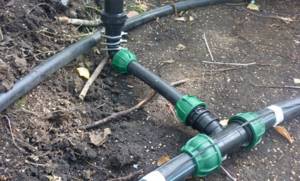
- Fitting. This group includes structural parts that are needed to design turning sections, branches, and also as transition connectors between pipes of different diameters.
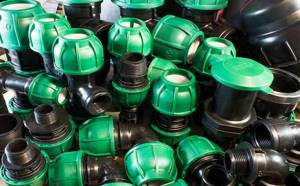
- Solenoid valves. The task of these devices is to open and close the water supply under the control of the controller.
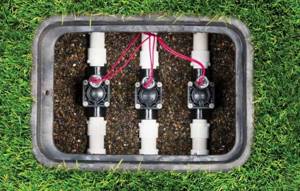
- Controller. The main device that controls the automatic watering system. It is equipped with a program that gives commands to open and close the valves. Sometimes an additional weather sensor is connected to the device. If it rains outside, it will signal the controller and the water supply will stop.
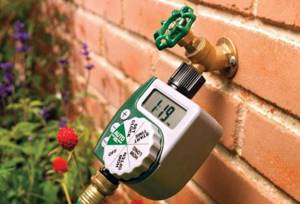
- Nozzles: sprinklers, drippers, sprinklers.
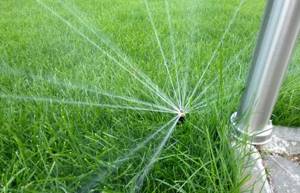
- Water intake sockets. These elements are not required, but sometimes their installation brings significant benefits. The sockets are mounted on the main pipe of the system. They are used to connect a hose if you need to water individual trees, shrubs or, for example, wash garden paths.

Development of a scheme for watering a lawn area with sprinklers
Designing automatic lawn watering begins with the development of technical documentation. This stage of work is carried out without fail, both by professional services and when arranging irrigation with your own hands.
There may be trees and shrubs on or near the lawn, and there may be slight differences in surface level. Lawns can be equipped with walking paths and places to relax. Therefore, before starting work, it is necessary to make a detailed site plan indicating all objects located on and near the lawn.
Next, a diagram for installing sprinklers is developed, which shows the radius of their action (it is available in the technical documentation for the device). The irrigation scheme with sprinklers should cover the entire lawn area and not cover pedestrian paths, recreation areas and other objects where watering is not desirable.
After developing the irrigation scheme, the total number of sprinklers is determined and separately - by the method of water supply (rotary, fan). Each sprinkler has its own water flow rate. Important: the total flow rate of all sprinklers should not exceed the capacity of the pumping unit.
When the sprinkler placement diagram is ready: the image is shown as an example,

You can begin to place the pipeline system. Here you should follow the recommendations for arranging on the same branch types of sprinklers of the same design - they should have the same performance. The minimum number of turns and other branches will reduce the hydraulic resistance of the irrigation system. The finalized pipeline system should be depicted on a plan using a drawing method, indicating the dimensions of the pipes, with all fittings and other fittings.
It is better to entrust the installation and configuration of electronic control systems, including a controller, solenoid valves, a sensor system and other electronic elements, to special service departments.

Such services can be provided not only by Moscow and St. Petersburg, but also other regions of Russia have corresponding service departments.
Calculation of water consumption - which storage tank to install
It should be borne in mind that the amount of water required to irrigate a lawn is not a constant value; it directly depends on the type of soil, its looseness, the type of grass planted, the shading of the lawn and weather conditions in general. On a hot day, the consumption will be greater, since some of the moisture will evaporate before it is absorbed into the soil. Dense soil is less permeable to water, which will facilitate the evaporation of some of the liquid scattered over the surface. If the lawn is shaded by trees or a building, almost all the moisture will go into the soil, which will reduce the duration of irrigation. On a hot day, water evaporates from loose soil just as easily as from the surface.

The average consumption rate usually corresponds to 15-20 liters per 1 square meter in order to saturate the soil to a depth of 15 centimeters with irreversible losses due to evaporation.
Knowing the required amount of liquid per unit area and determining the size of the lawn with flower beds and nearby flowering borders, it is easy to calculate the required volume of the tank. It is better to take a tank with a small reserve (from 20%) so that on a hot day you can afford to increase the water supply. An expansion or storage tank is needed not only to avoid a lack of life-giving moisture if the pressure in the city main pipes drops, but also to warm up the irrigation water, the temperature of which should not be less than 10 degrees. You should not place a tank that is too large so that the contents have time to warm up to the full depth in a day.

Assembling an automatic watering system yourself
Installation of automatic lawn watering is carried out strictly according to the developed technical documentation. The initial stage of work will be marking the site. Using pegs and twine, for example, the exact position of the sprinklers and the location of the pipeline are marked. Next, the trench is dug while its bottom is leveled with a slight slope towards the lowest point. They lay the pipes with their own hands and connect them with appropriate fittings. A filter is installed at the outlet of the pump.
Electromagnetic valves are installed in pipe branches with sprinklers. An electrical connection will run to them from the controller (a corrugated pipe hidden in the ground). Manually operated gate valves are installed at the entrance to the main pipeline and at the branches with sprinklers. Branches with manual valves can be equipped with drainage wells. This must be done in areas with cold winters, due to freezing of the soil layer with the pipe located in it. When the valve is open, water is drained through the drainage well (for which the slope was actually made). In its absence, the pipe will not freeze at subzero temperatures.
Before filling the trench, pressurized water should be supplied to the irrigation system and checked for leaks. If there are no assembly defects, the last operation is to screw on the sprinklers and backfill the trench with soil.
When setting up the system, the direction of watering the sprinklers is manually adjusted in accordance with the developed scheme. Maintaining the system is quite simple: cleaning the filters and nozzles, draining the water when preserving the system for winter conditions.
Semi-automatic humidification - savings and efficiency
If you determine in advance where the border of the lawn will be and possible changes in the size of the lawn in the future, you can lay pipes in the soil in advance. To do this, you need to dig ditches to the depth of freezing, or use insulation, burying the irrigation system in the ground so that the liquid does not turn into ice in winter and the pipes do not burst. The diagram should be drawn up in advance, taking into account the radius of water spray, which means that the power of the pump, as well as the types of nozzles, should be determined before installation. The ditches are laid along the lawn in rows, and one common one connects them. You can make a through system, closed, then there will also be a closing transverse pipe.
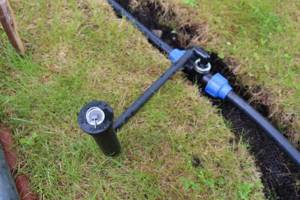
The semi-automatic system means that you have to adjust the pressure and irrigation sector yourself, using ball valves embedded in the network of plastic communications, which open or close to supply water to one or another branch of the system. At the beginning, near the pump, a common valve is installed, which shuts off the water supply to the entire laid network. To do this, a hole is dug and a special plastic well is laid, which is hermetically sealed with a lid from rain or melt water. The same wells should be placed in place of each ball valve; they can be made from plastic cans.

Water supply can be organized either from a central supply system or from a well or borehole. The last two options necessarily require heating the liquid in the expansion tank before use, as well as inserting a filter for additional cleaning. Otherwise, the injectors can very quickly become clogged with foreign particles and fail. In the case of expanding grass sowing, the pipe distribution can be expanded, but for this you should either purchase a pump with a power reserve in advance, or buy a new one so that the pressure is enough to water the additional area.

Where is automatic lawn watering used?
The main and probably the only drawback of this irrigation system is its high cost. Even if you install the equipment yourself, its price for an ordinary summer resident seems quite high. Therefore, it is very rare to find such an irrigation system in a dacha. But wealthy owners of country houses, when arranging a lawn in the landscape design of their local area, use automatic watering as an element of lawn care.
The best surface for the most popular sport - football - is considered to be grass lawns. However, it is not enough just to have beautiful grass; football players demonstrate high-quality, high-speed play on well-maintained fields. One of the important factors in the maintenance of a football lawn is the agrotechnical measures carried out during the process related to watering.
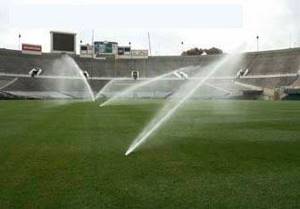
On the fields of stadiums where international football clubs play, automatic lawn watering systems with sprinklers are used.
Choosing a system for automatic watering
As with any industry, there are several types of lawn watering systems available in the landscape equipment industry. After reviewing all the options, you can make your choice.
Nowadays, there are two methods of automatic watering of a lawn. We are talking about sprinkler and drip irrigation methods.
Sprinkler irrigation
The sprinkler irrigation method is an irrigation system that is very close to natural irrigation in nature. The usual name for this method speaks for itself - sprinkling. The method of sprinkling is that a pipeline system is laid out across the entire lawn. Water is supplied through sprinklers (nozzles) and dissected in the air into small drops, like rain. Sprinkler irrigation helps reduce soil temperature and increase moisture in the air.

Sprinkler irrigation
The device itself that supplies water to the lawn is called a sprinkler, and depending on how it is installed, the sprinkler is divided into retractable and non-retractable.
Retractable sprinkler
The retractable sprinkler is invisible when not in use because it is hidden in the ground. But in the process of supplying water, retractable sprinklers reach the surface approximately 15-20 cm and their spraying range is 4-7 m. In turn, retractable sprinklers are:
- Rotary. Such a sprinkler consists of a stationary and rotating part. The rotating sprinkler head has blades that spray water in a circle. Unfortunately, very few people can boast of crystal clear water, not only for irrigation, but even for food. Therefore, if you do not install a filter (or do not check it when purchasing), then your system will often become clogged with impurities that are in the water. Rotary sprinklers can be adjustable, in which you can independently set the irrigation radius, while non-adjustable ones describe a clear specified circle (360o).
- Fan. Their design is very simple: a plastic body, a retractable rod, a non-rotating nozzle and a retractor spring. Water is sprayed 3-6 m. In some areas with elevation changes or dense tall bushes, only lawn watering equipment with a fan sprinkler can be effective due to its method of delivering water, somewhat similar to a funnel or the shape of an inverted umbrella.
Fixed sprinkler
A non-retractable sprinkler is installed in the ground and does not come out of the ground when water is supplied. Depending on the operating principle, non-retractable sprinklers are divided into four main types:
- Pulse. Such a sprinkler supplies water in portions and smoothly changes the irrigation range.
- Pendulum. This sprinkler is simply a must have for owners of rectangular plots. At the heart of pendulum sprinklers is a pipe with a hole that swings from side to side, watering your lawn without any gaps. Water spray range 6-20 m (can be adjusted by the angle of swing of the tube).
- Circular. The installation consists of a platform with a rotating head with attachments. Range 3-10 m, adjustable by water pressure.
- Sprinkler hose. We can say that, compared to previous installations, the sprinkler hose is a relatively new automatic watering system. The design is very simple: a hose (can be placed on the base to raise it) with small injectors for spraying. How many nozzles there are – this is how the watering will be (thick or sparse).
Drip irrigation
The drip-type automatic watering device involves the use of perforated hoses laid out over the lawn. They are connected to a water intake, but in this case the water does not come under pressure, but in small portions and it goes directly to the roots, which significantly reduces the amount of water supplied, and the plants receive exactly as much moisture as they need. In order not to spoil the neat appearance of the lawn, the pipes are hidden underground. The holes through which water is supplied do not become clogged thanks to the agrofibre layer.
Thanks to modern technologies, you can independently calculate water consumption. This is done using a custom controller. You can also set your preferred settings. For example, install valves so that automatic watering turns on when it’s hot and doesn’t turn on again after rain . Also, with the help of frost sensors, you will protect plants from hypothermia.
Video review of underground irrigation drip hose
Manufacturers
The leaders in the market for automatic irrigation systems are American manufacturers. The most famous of them are “HUNTER”, “RAIN BIRD”, “TORO” and others. They are distinguished by high quality products, offering both fully equipped automatic watering systems and its individual elements. Detailed information can be found on the manufacturers' websites.
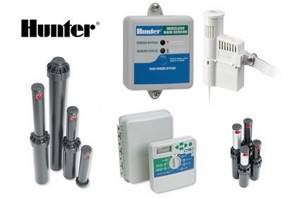
The products of Russian manufacturers, such as AQUA-SAD, for example, consist mainly of foreign components. The advantage of local manufacturers is the availability of a warranty period and the ability to order specialists for installation and commissioning of equipment.
Among the European manufacturers, we can highlight the Italian IRRITEC, which specializes in the production of fittings for plastic pipes used in automatic lawn watering systems.
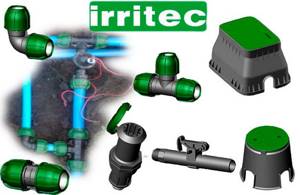
They are easy to install and do not require special equipment.
Organizing lawn care in a local area using automatic watering requires an engineering approach related to the design of the system. Not every lawn lover has technical education, mechanic and electrician skills when installing automatic watering. Therefore, you should make some financial expenses so that in the future you practically do not waste time on caring for the area near your home. Service specialists will design and install an automatic lawn watering system, then the grass on the site will always be green, despite the hot summer, and you will have a little more free time for yourself.
What is included in the irrigation system
Installing an irrigation system is a rather labor-intensive process, so be prepared for a lot of pain.
However, if you are serious, there will not be any special problems, especially since in the end, after the work is completed, you will receive a system that will provide you with free time in the future. So what's included in the system:
- Pumping station
- Filters
- Pipes, preferably plastic
- Controllers
- Pressure regulators
- Sprinklers
- Solenoid valves


